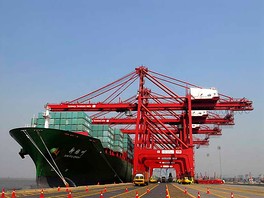 President-elect Donald Trump has repeatedly threatened to raise tariffs on imports into the United States, including imposing 45% tariffs on goods from China and 35% tariffs on Mexican goods. This post examines the authority of the President to unilaterally raise tariffs, and notes potential checks on the use of such authority.
The U.S. Constitution gives the Congress - not the President, the authority to regulate trade with foreign countries and to set tariffs on goods imported into the U.S. As a consequence, until the 1930s, the legislative branch generally established U.S. tariffs. Since then, the Congress has increasingly delegated authority to the President to establish tariffs, when specific criteria are met.
Congress’s delegation of tariff-setting authority to the President comes in two broad categories. First, beginning with the Tariff Act of 1934, the Congress has authorized the President to negotiate the reduction or elimination of tariffs in the context of international agreements, including World Trade Organization agreements and bilateral and regional free trade agreements (FTAs). The most recent authorization was the Bipartisan Congressional Trade Priorities and Accountability Act of 2015, also known as Trade Promotion Authority, which provided for tariff negotiations in the Trans-Pacific Partnership (TPP) Agreement.
In the second category of delegation of tariff authority, Congress has given the President broad power to raise tariffs when certain requirements are met. Legislative measures that provide such authority include:
President-elect Donald Trump has repeatedly threatened to raise tariffs on imports into the United States, including imposing 45% tariffs on goods from China and 35% tariffs on Mexican goods. This post examines the authority of the President to unilaterally raise tariffs, and notes potential checks on the use of such authority.
The U.S. Constitution gives the Congress - not the President, the authority to regulate trade with foreign countries and to set tariffs on goods imported into the U.S. As a consequence, until the 1930s, the legislative branch generally established U.S. tariffs. Since then, the Congress has increasingly delegated authority to the President to establish tariffs, when specific criteria are met.
Congress’s delegation of tariff-setting authority to the President comes in two broad categories. First, beginning with the Tariff Act of 1934, the Congress has authorized the President to negotiate the reduction or elimination of tariffs in the context of international agreements, including World Trade Organization agreements and bilateral and regional free trade agreements (FTAs). The most recent authorization was the Bipartisan Congressional Trade Priorities and Accountability Act of 2015, also known as Trade Promotion Authority, which provided for tariff negotiations in the Trans-Pacific Partnership (TPP) Agreement.
In the second category of delegation of tariff authority, Congress has given the President broad power to raise tariffs when certain requirements are met. Legislative measures that provide such authority include:
- 1977 International Emergency Economic Powers Act: IEEPA gives the President the authority to respond to “any unusual and extraordinary threat”, from outside the U.S., “to the national security, foreign policy, or economy of the United States", after the President has declared a national emergency. Under IEEPA, the President can take a variety of actions to curtail international commerce, including raising tariffs.
- Section 301 of the Trade Act of 1974: Section 301 authorizes the Executive branch to retaliate against a foreign country whose act, policy or practice: (i) violates, or is inconsistent with a trade agreement, or otherwise denies benefits to the U.S. under an agreement, or (ii) is unjustifiable and burdens or restricts U.S. commerce. The retaliatory actions may include the imposition of tariffs or other import restrictions. Congress enacted Section 301 as negotiating leverage to ensure compliance by foreign countries with trade agreements and to eliminate restrictions and other distortions to trade. (A subsequent post will address challenges of resorting to Section 301.)
- Trade Expansion Act of 1962: Section 232 of that Act provides that, where the Secretary of Commerce finds that an article is being imported into the U.S. "in such quantities or under such circumstances as to threaten to impair the national security”, the President may take necessary actions "to adjust the imports of such article so that such imports will not threaten to impair the national security”. Those actions could include imposing tariffs or quotas to offset a negative impact on trade.
Post Permalink: https://trade.djaghe.com/presidents-authority-to-raise-tariffs/

